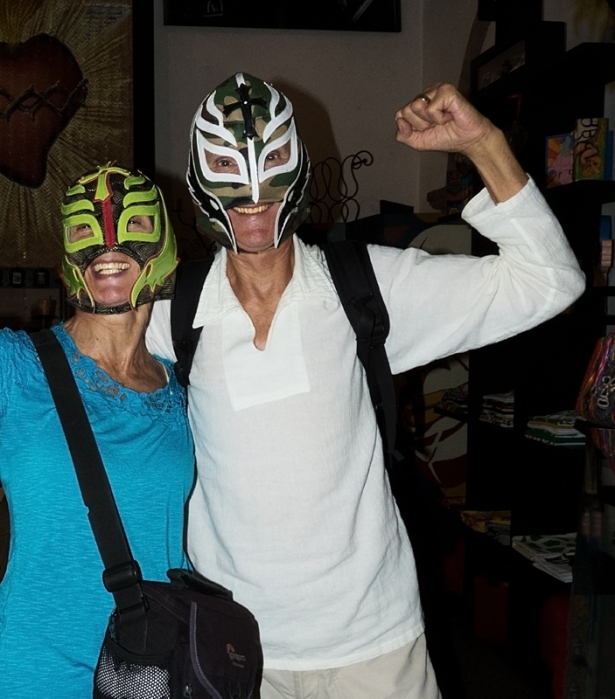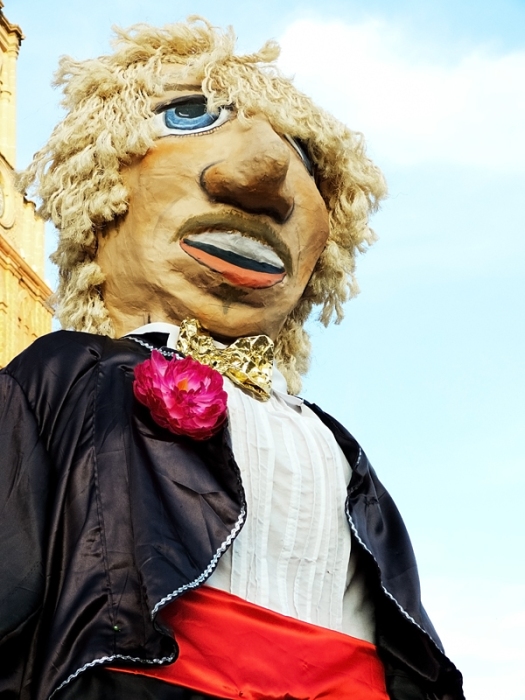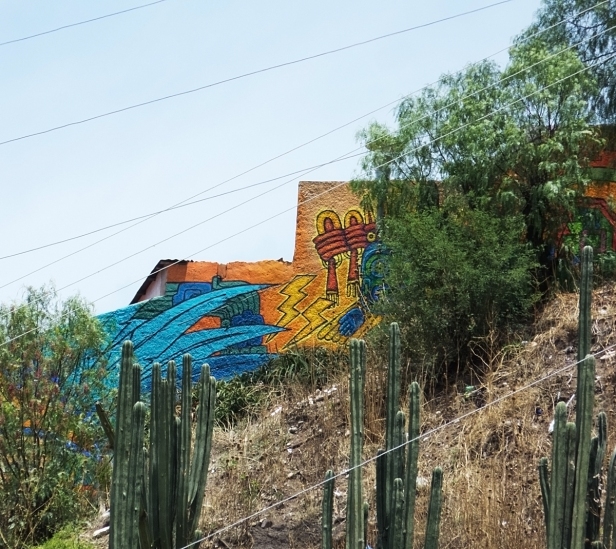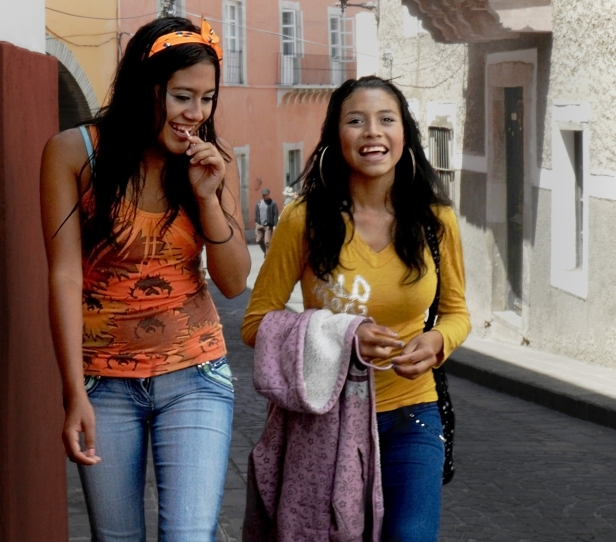22-29 June 2013. The first thing I have to report is that we bought our grandsons Mexican wrestlers’ masks. Of course we had to try them on to make sure they worked properly!
We hired a driver to take us to Guanajuato for the day. It’s the capital of the state of the same name and about an hour from San Miguel. The driver, it turned out had another job – performing, (the following night) with a group of fellow actors, in an enactment of some of the history of San Miguel, it being the birthplace of the revolution to free Mexico from the Spanish in 1810. The performance was a mobile play wherein the actors and audience alike moved from building to building in the centre of San Miguel as various significant events were acted out. Unfortunately for us it was acted in Spanish, and although there was always one member of the cast with us explaining in English, I think we missed the details, though we surely didn’t miss the emotion and body language of the performers. It was a fun way to see some of the historic buildings, and to learn some of the history of San Miguel. It is regarded as the first town to be freed from Spanish rule.
This is the man who was our tour guide one day, and important personage from the 19th century the next. He told us he also made the costumes for the company. Versatile guy.
The performance began in El Jardin, the main square of the town. We’d been there several times and it was always busy. It’s the place where people gather to meet, and to hang out. On a Friday night it was hopping.
There were two pre-wedding parties. Each group, apart from the hundred or so guests and the bride and groom, had its own Spanish-style band, and mojigangas (mo hee gangas) of the bride and groom. A mojiganga is a giant puppet about 15 feet tall built over a large frame and designed in such a way that the legs and feet of the person inside the structure become the legs and feet of the puppet. They are startling, glorious, breathtaking, hilarious, wildly creative and impossible to ignore. We were completely captivated. The dancing mojigangas led the wedding parties around the town as the guests drank and the music played.



One of the wedding bands – just like one we saw in Barcelona:
Then there was this guy. I’m not sure what he was offering. Maybe he was connected with one of the wedding parties but I’m not sure. The blue box on the donkey has “propinas” written on it. It means “tips”. Tips for what?
And this guy, who rode into town with his donkey to sell bottles of wine.
And of course the whole company of actors, about eight of them, in 19th century period dress, and dozens of other people just hanging out. I was still not sure if I was in Mexico or Spain. It was the most fun we’d had in ages.
The day before we’d spent the day in Guanajuato, a town even more European in feeling and style than San Miguel if that’s possible. It’s a university town in a narrow valley. Most of the streets are alleys going steeply up the hills on either side of the valley and are impassable by cars. There are a few streets for cars in the town, and a few open spaces in the centre.
A network of underground tunnels that follow the original drainage ditches built for flood control of the Guanajuato River now form the main roads throughout the town. The story goes something like this – the town evolved in this really narrow valley due to very rich deposits of silver nearby. The Guanajuato River at the bottom of the valley would flood during the rainy season so they built ditches all over the place for run-off to prevent flooding. Eventually there were enough run-off ditches that the original riverbed was covered over to form a tunnel, and then used as a road. Then in the mid 1900’s a dam was built to completely redirect the river, so all the ditches were covered over forming this vast network of underground roads beneath the city. There are frequent openings with stairs up to the town. It’s quite surreal really. These photos show the buildings on top of the original tunnel of intricate brickwork, which predates the rest of the tunnel network by quite some time.


The town from above.
There are a few open spaces in the centre of town,

this gorgeous wall up the hill on one side,
and university students everywhere.
and one from Don.
Since we only had one day in Guanajuato we had to pick and choose. We passed on the mummy museum (111 mummies unearthed from the local cemetery because of the law that taxes must be paid after a certain number of years of being interred – no one knows why they mummified instead of rotted), and the Don Quixote museum (created by a large contingent of Spanish residents in Guanajuato), and instead went to the Juarez Theatre for it’s beauty, the Diego Rivera museum to see some of his early work, and then went to explore what most interested us about this town – the tunnels, and the narrow streets of colourful houses.
This is the stunning interior of the Juarez Theater, designed by architect Antonio Rivas Mercado, and built from 1892 to 1903.

From the tunnels we climbed the steep narrow colourful winding streets.





We climbed about half way up and then went into a restaurant for a view of this prettiest of towns. We loved Guanajuato. Everywhere we looked it was pleasing to the eye. It felt rich. Maybe in material terms, but also rich in life and lifestyle and creativity and learning.
In the restaurant we were astonished by these chairs. This lady (and you know she’s a lady because of her earrings and her quite magnificent hat!) both forms and adorns the back of the chair. All the chairs were like that, some with skulls, some with suns. They make me smile. She is a Catrina, the icon of Mexico’s Day of the Dead.
This is Don’s photo of Pipila.
Pipila sits atop one side of the town and dominates the skyline. He was a miner from San Miguel, and he was a hero in the early movement for independence. On 28 September 1810, all the Spanish rulers of Guanajuato had locked themselves and their families, and plenty of silver, in a grain warehouse, in the hope of being safe there. Carrying a big rock on his back, and using it as a shield, Pipila was able to set fire to the wooden doors of the warehouse, and thus the Mexican rebels gained entry and all inside were massacred. It was just the beginning and took much more fighting, and much more time before Mexico finally gained independence, but it all began in San Miguel de Allende, and Guanajuato.
Next stop: nearly three weeks in the fabulous state of Oaxaca for the incomparable Guelaguetza Festival, a trip to some Zapotec ruins, and a hike in the surrounding mountains – all to come in the next few posts.
All words and images by Alison Louise Armstrong unless otherwise noted.
© Alison Louise Armstrong and Adventures in Wonderland – a pilgrimage of the heart, 2010-2015.

You’re right, it does look surreal! I love all the photos, but I think the wrestling masks one made me smile the biggest. 😀
LikeLike
Thanks Rara. Aren’t those masks wild?! Can’t wait to see the boys when they get them (they’re about 6 and 8 I think).
LikeLike
thanks. i almost made it here once. now i’ve been-kinda.
LikeLike
You’re welcome. Great place eh?! 🙂
LikeLike
This is such a gorgeous post, Alison! Any chance that Guanajuato is a world heritage site? From your photos it looks completely deserving of such a title. I’ve heard the town is a popular place for students to come and learn Spanish, and now I know why! The narrow and colourful streets remind me so much of southern Spain, and the Juarez Theatre is just exquisite, I can just imagine sitting there and listening to a concert, surrounded by all that beauty.
Had no idea of Guanajuato’s underground roads either – it would be the perfect setting for a period thriller based on Mexico’s struggle for independence. Thanks for adding this beautiful town to my ever-growing wishlist, no doubt you and Don would have stayed a few days if you could!
LikeLike
Thanks so much James. Yes, I do think it is a World Heritage site. I agree it certainly deserves to be. And the whole underground road network was just fascinating, but I wouldn’t want to be having to walk around there at night – kinda spooky. There’s a myth about a ghost there too 🙂
LikeLike
That theatre is amazing! (and I’m hurt that you did not get me a lucha mask : )
LikeLike
Isn’t that theatre just exquisite! And I only showed a bit of it. On the outside it has a whole row of classical statues along the front of the roof like St Peters in the Vatican. Amazing building, but for me more beautiful inside than out.
Lucha smucha 🙂
LikeLike
Cool…your Grandsons will love those masks. I love all the amazing colours in your photos..what a vibrant culture!
LikeLike
Thanks Lakshmi. Oh Mexico is vibrant alright. Just wait til I start on the Guelaguetza Festival pics – just breathtaking. We have a whole different appreciation of Mexico now – a really rich vibrant creative people.
LikeLike
Gosh! Juarez Theater looks so exquisite and magnificent. I can imagine myself being there and looking up to those ornate decorations. Marvelous! And the town itself looks like a very nice and charming place to walk around and spend some time. Alison and Don, I think everywhere you go, you’ll end up making us, your readers, drool for the beauty of those places. This post has just done that to me.
LikeLike
Thank you so much Bama. I’m glad you enjoyed it. Both San Miguel and Guanajuato are certainly drool-worthy. And yes, the theatre is absolutely exquisite.
LikeLike
Those masks are so cool. Your grandsons will enjoy them! Great colors in the photos. Amazing that some of the poorest countries have some of the most vibrant colors.
LikeLike
Aren’t those masks cool! We loved them and they’re exactly right for the boys.
It’s interesting how much our perception of Mexico has changed. There’s no doubt there are a lot of poor, and even very poor people there, but there’s also a big middle class, and of course the wealthy. I’ve never been in a country where I’ve been so aware that almost all the tourists wherever we went were Mexicans on vacation. Most of the people attending the big festival we went to were Mexican. I think it’s maybe a poor country, but not in the way Cambodia and Laos and some of the African nations are. Comparatively it seems to be doing quite well. And very colourfully!
LikeLike
Boy that’s a reality check and interesting to read. Thanks. I see that I had this slanted view, from all the immigrants that arrive here, dirt poor, trying to make a better life, etc. Appreciate your comment. xoxo
LikeLike
Yes it’s been a reality check for me too. I think the issue of poor immigrants into the US (usually illegally I’m thinking) is very real. And I think the issues with drugs and drug gangs is also real – in some parts of the country. *And* there’s this whole other population and culture happening there as well. What we encountered was a country with a very very rich culture and people very proud of their heritage and their country. It was quite wonderful.
LikeLike
All of the photos are great, but the photo of you two in the Mexican wrestling hats TAKES THE CAKE!
LikeLike
Thanks Laurie. I must say I hadn’t really thought to have our photos taken in wrestling masks, but we tried them on and the lady in the shop offered to. How could I not publish it lol! So much fun.
LikeLike
Love that city, Alison. You are right–it is a rich city, especially in color. Like Rara, I love the wrestling masks. I also love the mojigangas. I wonder who takes those home after the wedding? Can’t wait for Oaxaca. {{{hugs}}} Kozo
LikeLike
Thanks Kozo. Yes we loved both towns. Swooning over the colours. And the mojigangas! Aren’t they great! Literally! Wish I could have gotten a full head to foot shot.
LikeLike
The town looks so clean! On one picture I saw graffiti, but that was it. I didn’t see any litter. And the colors – they make me swoon!
LikeLike
Oh I just said to Kozo that we were swooning over the colours! And yes clean. Mostly in Mexico we saw just the normal amount of graffiti (less than we saw in Rome for instance!), and Mexico also has fabulous murals, like the fence above. Mexico is not the cleanest country in the world but India could certainly learn a thing or two about keeping the streets clean! I do also think though that both San Miguel and Guanajuato are quite special towns, also Oaxaca which I’ll write about next, so maybe not typical. But then the little fishing village we stayed in was clean too. Mexico has become a different country to me. There’s a very rich cultural heritage here that the people are rightly proud of.
LikeLike
Wow – thanks for taking the time to write all that! I had a friend in college who was from Mexico, and although he clearly loved it, he didn’t speak well of it. He said it was very dangerous, and corruption was rampant. It’s so nice to hear your impressions, so my thoughts of Mexico can soften.
LikeLike
We both softened towards Mexico a lot as a result of our time there and discovered a country and a people that we didn’t know existed. Also see my above replies to Paulette (in case you haven’t read them yet) there’s a bit more of my impressions there. I think I should write about this in my final post about Mexico – when I finally get to it. (I figure there’s about 5 more posts to come on our time on Oaxaca and Mexico City)
xoxox
LikeLike
Beautiful town Alison. Once again, your photos bring it to life. As for wrestling masks, we even bought one for our son-in-law. 🙂 –Curt
LikeLike
Thanks Curt. Love those wrestling masks. And does your son-in-law ever wear it? 🙂
LikeLike
Oh, I love your pictures! So, so, so very cool. Heading over to your “Spain” page to find any posts on Madrid or Barcelona. If you haven’t posted on either, can I make a travel request for you two? We’re heading over there in 2014 and looking forward to every minute of it.
LikeLike
Thank you so much. I’m glad you enjoyed them. I’m sure you discovered by now that we didn’t go to Madrid. Barcelona is amazing. You’ll have a fabulous time!
Alison
LikeLike
Your post is a trip down Memory Lane for me. In 1963,when I was 9, my parents, rented out our Philadelphia row house, packed my 2 younger sisters and me into their 1957 Chevy and drove to Mexico. My father was a potter (a public school art teacher) and he took a sabbatical to find a Mexican potter to work with. I guess before the internet, you just did things and figured it out as you went along. He thought we would stay in Guadalajara, but when we arrived there, he didn’t like it. Someone told him about San Miguel de Allende and off we went. (It’s hard to describe that year in a blog comment, but I did write about it on my blog). In February of 2012, I took my husband back to San Miguel after not having been there for 48 years. (I blogged about that too). What was kind of amazing was how so much of it seemed familiar — the jardin, the giant puppets, la parroquia, the streets. I could find my way around to show my husband where we lived, where my father worked, the market, etc. We even stayed in a guest house around the corner from where we stayed when we first arrived in 1963 — now run by the daughter of the original owner with whom I’d been sent off to school with way back when.
LikeLike
Wow, what a wonderful story. Thanks for sharing that. That must have been an amazing adventure for a 9 year old. Did you learn Spanish? It’s such a beautiful city – we quite fell in love with it.
Did you notice that I have another post on San Miguel? – just in case you want another trip down memory lane 🙂
Off now to look at your posts!
Cheers
Alison
LikeLike
Thanks, Alison. I’ll look for your other post. I want fluent by the time we left San Miguel—too many Americans— and then I returned to 6th grade in the US where we didn’t start foreign language study until 9th grade. I studied Spanish through high school and had it as one of my two college majors. In 1974, I spent a semester at the University of the Andes in Bogotá, what all my classes were in Spanish. Best of all, I lived with a Colombian family which really helped. I had a good accent all through this (I.e. I didn’t sound like a gringa) which I attribute to having gotten the sound of the language embedded in my brain when we lived in Mexico. I ended up as a lawyer and used Spanish just about everyday as many of my clients were Hispanic.
LikeLike